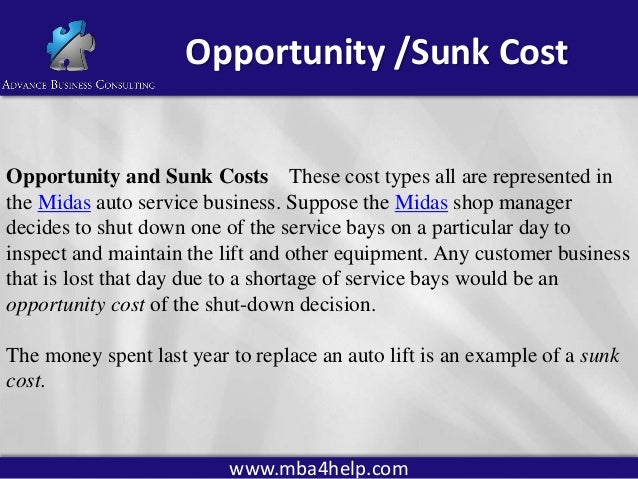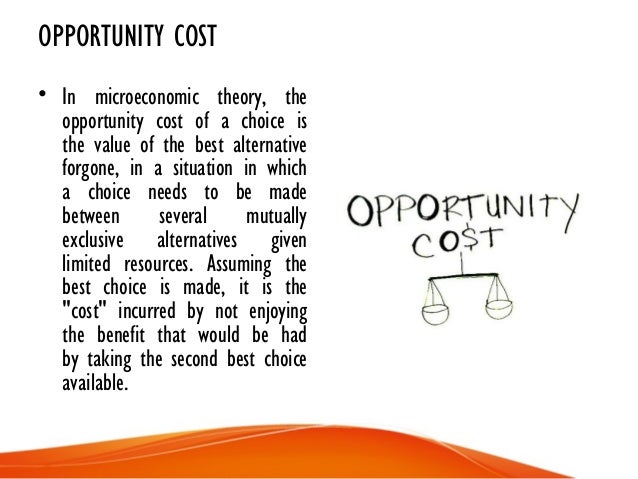See? 37+ List Of Opportunity Cost Vs Sunk Cost Your Friends Did not Tell You.
Opportunity Cost Vs Sunk Cost | In microeconomic theory, opportunity cost is the loss or the benefit that could have been enjoyed if the alternative choice was chosen. These are almost always opportunity. La differenza principale tra il costo sunk e il costo di opportunità è che il costo dell'opportunità può essere utile per prendere decisioni strategiche. For example, if you were making a decision cost classification refers to different kinds of existing costs in economics. Sunk cost refers to a cost which has already been incurred, thereby can not be recovered.
The sunk cost for the company equates to the $5,000 that was spent on the market and advertising means. In microeconomic theory, there are opportunity costs, fixed and. Sunk costs are those which cannot be altered, increased or decreased by changing the rate of output and the level of business activity. The concept of opportunity cost has important implications both in business and in everyday life, so it's important to understand it. La differenza principale tra il costo sunk e il costo di opportunità è che il costo dell'opportunità può essere utile per prendere decisioni strategiche.

In this article, we will learn what is opportunity cost, examples, sunk cost, explicit cost, and implict cost. 1) the trend is not your friend, on major selling (11+m shares wednesday, sept 27 vs average of 2.6m per yahoo finance. As such, in the following article you will learn more about opportunity cost, and understand how you can account for it as effectively as possible. Opportunity cost is a concept in microeconomics that tells you about the output and potential opportunities foregone. La differenza principale tra il costo sunk e il costo di opportunità è che il costo dell'opportunità può essere utile per prendere decisioni strategiche. Opportunity cost is the loss or gain of making a decision. In microeconomic theory, there are opportunity costs, fixed and. Opportunity cost is all about the most basic of economic concepts: Conventional economics is based on rationality, that people always make decisions to maximize their wealth or their utility. By the end of this section, you will be able to: All the past costs are considered as sunk costs because they are known and given and cannot be revised as a result of changes in market conditions. Sunk cost refers to a cost which has already been incurred, thereby can not be recovered. Risk creates a potential situation where the return of an investment will be lower than the.
For example, if colin always gives up producing 2 fidget spinners. By the end of this section, you will be able to: Sunk cost or unavoidable cost refers to the unrecoverable cost that has been already incurred in the past. Using opportunity cost to compare investments. Sunk costs can also be considered in terms of opportunity costs.

Sunk costs (also referred to as historical costs) are costs that have been previously sustained and cannot be recovered. Using opportunity cost to compare investments. In this article, we will learn what is opportunity cost, examples, sunk cost, explicit cost, and implict cost. All the past costs are considered as sunk costs because they are known and given and cannot be revised as a result of changes in market conditions. In microeconomic theory, there are opportunity costs, fixed and. A typical example for sunk cost in the oil and gas industry is the cost that has been spent. Costs may be classified as differential cost, opportunity cost and sunk cost. A sunk cost is a cost that has already occurred and cannot be recovered by any means. As such, in the following article you will learn more about opportunity cost, and understand how you can account for it as effectively as possible. Opportunity costs on the other hand are costs which do not necessarily involve any cash outflows but which need to be considered because they reflect the therefore, in calculating net initial investment outlay, analysts need to ignore the sunk costs but include opportunity costs in their analysis. Conventional economics is based on rationality, that people always make decisions to maximize their wealth or their utility. A sunk cost is a cost that has already been incurred, and thus shouldn't factor into management decisions. For example, if you were making a decision cost classification refers to different kinds of existing costs in economics.
A typical example for sunk cost in the oil and gas industry is the cost that has been spent. Make no mistake, it all comes down to sacrifice vs. In cost accounting, there are specific costs related to planning and decision making of business activities. Sunk costs are those which cannot be altered, increased or decreased by changing the rate of output and the level of business activity. Sunk costs are costs that have already been incurred in the past and that nothing we do now or in the future can affect.

All the past costs are considered as sunk costs because they are known and given and cannot be revised as a result of changes in market conditions. The difference between an opportunity cost and a sunk cost is the difference between money already spent in the past and potential returns not earned in the future on an investment because the capital was invested elsewhere. In other words, it's the money, time, or other resources you give up when you choose option a instead sunk cost refers to money that has already been spent and can't be recovered. Opportunity cost can be defined as weighing the sacrifice made against the gain achieved when making tough money, career, and lifestyle decisions. Using opportunity cost to compare investments. For example, if colin always gives up producing 2 fidget spinners. Conventional economics is based on rationality, that people always make decisions to maximize their wealth or their utility. An analogy which demonstrates this principle is, don't cry risk and opportunity cost also require significant distinction. In microeconomic theory, opportunity cost is the loss or the benefit that could have been enjoyed if the alternative choice was chosen. So if the survey result is bad and. Sunk cost refers to a cost which has already been incurred, thereby can not be recovered. Opportunity cost, on the other hand, refers to money. This classification is made for decision making purposes.
Opportunity Cost Vs Sunk Cost: As such, in the following article you will learn more about opportunity cost, and understand how you can account for it as effectively as possible.
Source: Opportunity Cost Vs Sunk Cost
0 Response to "See? 37+ List Of Opportunity Cost Vs Sunk Cost Your Friends Did not Tell You."
Post a Comment